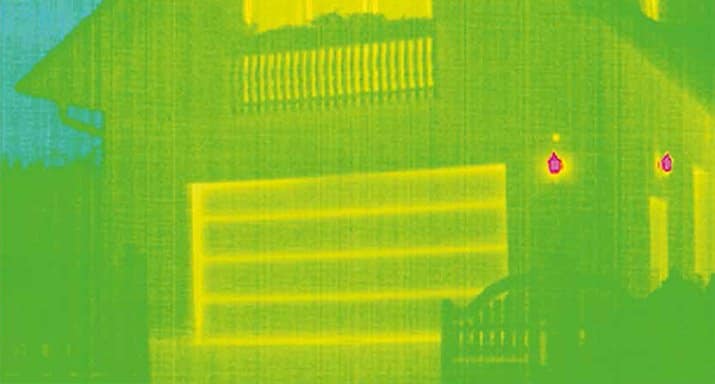Insulated Garage Doors, U-values and energy bills

In the past insulation was never really considered a big factor for a garage door. Doors were constructed from timber or single sheets of steel and they were designed to primarily fill a hole. Having gaps around a door was part of the design and not particularly unusual. Technology, construction methods and consumers needs have changed quite a bit since the early days of garage doors however, and there are now a large number of insulated and sealed garage door products on the market. So let’s take a look at what constitutes an insulated garage door and exactly what it has to offer.
What is an insulated garage door?
The image below shows a cross section of a Hörmann LPU40 sectional door panel. Hörmann’s panels are 42mm thick and feature a rubber seal that protects and insulates each panel.

How does that affect my garage?
The method of installation will also have an effect on the levels of insulation as this usually determines how the door and frame are sealed against the garage. A sectional type door installed fully behind the opening usually offers the highest levels of insulation as the door and frame will be sealed fully against any brickwork. If a smaller height door needs to be installed then it is worth thinking about how any gaps are finished. Matching PVC or steel will deliver an aesthetically suitable and cost effective solution but it will not offer very high levels of insulation and can undermine the thermal qualities of a door. Some manufactures offer matching insulated fascia panels though these will obviously add to the cost.
The floor level will also have an impact on how well the bottom seal of a door can provide insulation. Any uneven or sloping garage floors can present gaps in the bottom edge or seal of a door and have an impact on the levels of insulation.
U-values and energy bills
There are a number of ways to calculate and present the insulating properties of a product but the most common method that is relevant to the construction industry is a U-value. The U-value is a measurement that shows how much heat is lost through a particular material or product. It takes the three main methods of heat loss into consideration – conduction, convection and radiation and it is measured in watts per metres squared kelvin, or W/m²K.
Whilst this may sound complicated the main thing to note is that lower values indicate better insulation and the nearer to zero the better.
To give you some idea of how U-values relate to real life situations here are some examples;
A typical hardwood external entrance door = 3 W/m²K
A typical composite entrance door = 1.8 W/m²K
A typical single glazed window = 4.8 W/m²K
A typical modern double glazed window = 1.6 W/m2k
A typical standard steel up and over door fitted = 7 W/m2k
A 42mm insulated sectional door fitted = 1.4 W/m2k
Do bear in mind that U-values are really only a guide and there are other factors, as we have mentioned previously, that will affect that the final insulating values that a particular door installation will provide. But ultimately the lower the U-Value, the less you are going to pay in energy bills if the garage is attached to your home.
Types of insulated garage doors
Sectional garage doors
Insulated roller garage doors
There are a number of factors that vary between manufacturers that will have an impact on the thermal performance of the door and generally speaking, the old adage ‘you get what you pay for’ is particularly relevant here. Features such as the webbing, brush strip, the type of tracks and guides used and the depth that the door sits in the tracks will all have an effect on the overall performance.
Side hinged doors
Side sliding doors
Up and over doors
For more information on insulated garage doors and U-values why not drop into our showroom or contact a member of our dedicated sales team.
ABi garage doors specialise in the suppy, installation and repair of garage doors, entrance doors and remote controls covering the entire Yorkshire region including Leeds, Bradford, Wakefield, York and Huddersfield.
